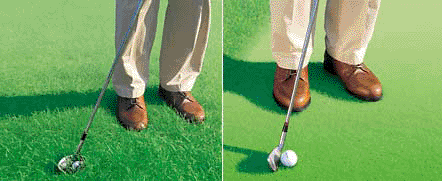Breaking 90: Build precision into your game Created on 4/4/2001 12:00:00 AM
Breaking 90: Building Precision 
The basic rule for chipping is, the worse your lie, the farther back in your stance you
need to play the ball and the more loft you have to use.
If you're a bogey golfer, you probably average one really good shot per hole--a drive in the fairway, an approach onto the green, a good chip or a good putt. Now you want to develop more precision. Someone who shoots in the 80s keeps it in play and is much better around the green.
Let the lie determine your stance on greenside shots
The basic rule for chipping is, the worse your lie, the farther back in your stance you need to play the ball and the more loft you have to use.
For each of the shots shown above, I've got the same distance to the flag. But for the shot on the left, my ball and club are tangled in deep grass. I'm using my sand wedge, and I'm playing the ball well behind my back foot, so I can bring the club down on the ball without having to drag it through a lot of grass. I need the sole of the sand wedge to help me slide through the grass and the loft to get it up.
My lie is perfect for the shot on the right. I can chip with a 7-iron, playing the ball nearer my front heel. The ball should hop over the fringe and roll like a putt when it lands on the green.
The basics of bunker shots
You'll encounter three basic lies in a greenside bunker--hardpan (the ball sitting on top of hard sand), the fried egg (the ball half-buried in its own crater) and a straightforward, good lie.
To play from hardpan, you don't want to expose too much of the sand wedge's flange--if you do, the club will bounce and you'll skull it over the green. Keep the clubface square, and hit from a slightly open stance. Use the leading edge to dig.
From a buried lie, you need even more digging, so close the face. Put more weight onto your left foot and attack the ball from a steep angle.
For a standard bunker shot, use the sand wedge the way it was designed. Open the clubface so it can skid through the sand and blast the ball out. Your stance should be open, and you should play the ball off your left instep.
Ease grip for flexibility
A relaxed grip helps the wrists hinge well on the backswing. If you were holding a tube of toothpaste, you wouldn't be squeezing hard enough to squirt any out.
How would you toss the ball?
When trying to decide what club to use around the green, imagine how you would throw the ball up there by hand to get it close. Then pick the club that matches that ball flight.
Don't try to be a hero
On high-risk shots-- like trying to hit through a small gap in the trees--the most you can save is one shot, but you create the possibility of losing two shots or more. Play it safe.
Golf Digest April 2001

